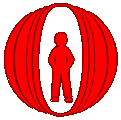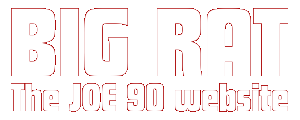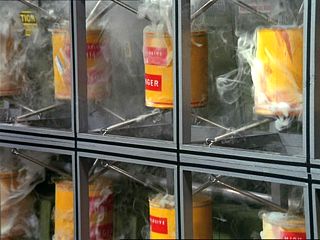 |
Whenever I think of Joe 90 my first thought is of
a row of smoking containers marked High Explosive - Danger bouncing
up and down on support springs.
This scene is from the episode
Colonel McClaine in which
our hero drives one of three trucks, over 200 miles of dangerous terrain,
to transport 150 litres of highly unstable U114 explosive to Kuchunga.
This episode is my favourite of the series and also features my favourite
guest vehicle that is simply known as the Explosives Truck.
|
|
Like many vehicles in this series it was designed by Mike Trim and
is notable for the fact that it is seen as the prototype for the popular
SHADO Mobile from Gerry Anderson’s later series UFO.
For this episode four models had to be built: truck 61 driven by
Joe, truck 59 driven by ‘Sarge’, truck 58 operated by the reluctant
Private Johnson and finally a less detailed dummy model built for an
explosion SFX shot.
|
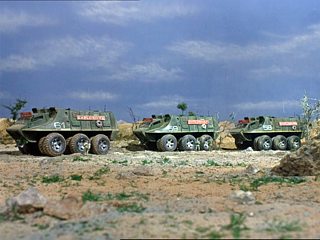 |
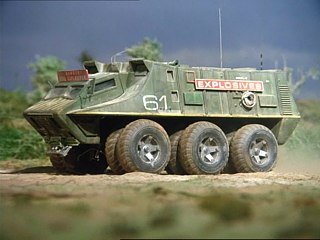 |
The three hero models were very similar to each
other with only a few minor differences, one being that Joe’s truck
had a door cut into the left hand side of the driver’s cabin (probably
for a shot that was deleted from the final script). The other differences
were caused by the physical knocks the models received during filming
which resulted in a number of the glued on kit parts dropping off the
models, most notably on the sides and the front ‘chin’ section. |
| Although scenes can be filmed in any order it
is probably fair to say that most of the major SFX sequences were filmed
in script order, as the models start out in good condition and at the
end look pretty well beaten up. Also, after the shots featuring all
three trucks had been completed, ‘Sarge’s’ number 59 truck was outfitted
with 61 markings which would have allowed a second SFX unit to film
additional shots of Joe’s vehicle to ensure the episode was finished
on time. |
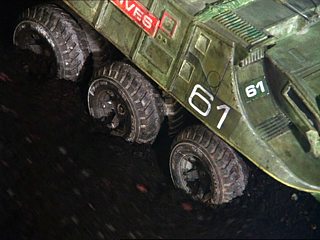 |
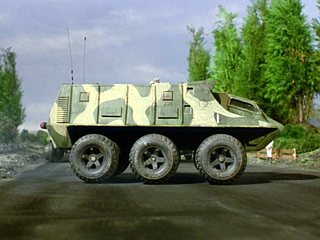 |
After the episode was completed the three models
were added to the model store and made further screen appearances in
later shows. Private Johnson’s truck 58 appeared in
The Race minus its signage
and with khaki camouflage markings simply painted over its old dirty
green finish. |
| Most notably Joe’s number 61 model appeared
in the episode Breakout.
Here it was painted red, had ‘Cherook Penitentiary 3’ markings and a
modified rear end, involving the removal of about an inch of its length
and a flat rear bulkhead fitted with twin doors. |
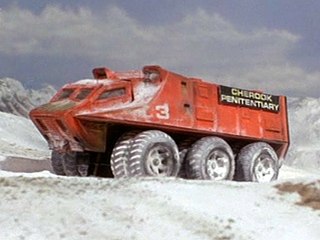 |
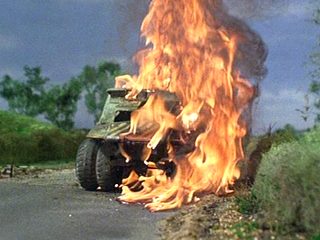 |
Truck 59, still sporting 61 markings and with
the addition of a flashing light on the drivers cabin, made its final
appearance in The Secret Service episode School
For Spies where it was blown up half a dozen times and then left
to burn. |
| I’ve wanted to build a replica of this model
for many years but was always put off by the fact that I could never
find the wheels that were used on the original. The toy wheels and tracks
used on the Mobile and SPV models have been identified for a while now
but these chunky wheels that also appear on models in Captain
Scarlet and The Mysterons and UFO never have
been — even with the words 'Johnny Express Super Wide' written around
the edge*. Mike Trim remembers the models making a loud noise as they
rolled over the roadways and thinks the wheels may have been castings
taken off a wheel they had found somewhere. |
 |
After searching toy fairs for years I finally gave in and realised that I
was going to have to scratch build them after all. The first problem was to
figure out how big the original model was and draw up a blueprint. Normally
I only start a model when I have a lot of photographic reference material including
the all important profile pictures. Unfortunately I only had a couple of publicity
photos, which was completely inadequate, but the models were featured heavily
in the episodes and are filmed from every angle, and as they are also covered
in around sixty model kit parts (which are still available) it was possible
to complete the project.
 |
I decided to make the model in fibreglass so
the master pattern was made in three sections: the upper hull and the
lower front and rear pieces. As the vehicle is almost entirely made
up of flat panels I fabricated it all in plasticard and Perspex sheeting. |
|
This picture shows the completed hull with the curved areas built
up in car filler. Although the shape looks simple and quick to build
it did require a lot of alterations. Every time I completed the shape
I compared it to freeze frame images on my television, marked any area
that didn’t look correct and then broke the model down and rebuilt it.
|
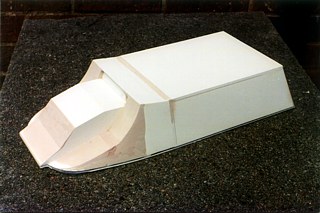 |
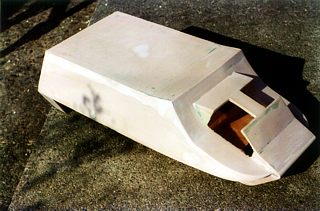 |
This is the fibreglass shell produced from plaster moulds taken from
the plastic masters. I decided that my model would deviate from the
originals by having two door/hatches in the cabin — to me this looked
more realistic and made access to the interior a lot easier.
|
|
Lengths of hardwood were fixed to the inner edges of the hull onto
which a 4mm Perspex plate was screwed that the chassis could then be
glued to. The front third had to be blanked off before the lower cabin
could be attached; this was done by simply gluing the hull to a flat
glossy surface and pouring resin in through the open cabin doors.
|
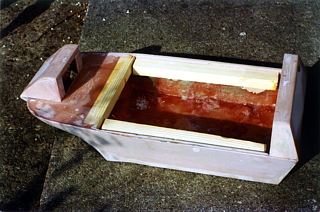 |
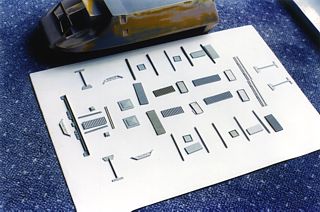 |
These are some of the kit parts needed to detail the outer surface
of the model. They come from three old Airfix kits that are now made
by a company called Dapol: The Girder Bridge, the Signal Gantry and
the Foot Bridge.
|
|
Apart from the kit parts, the hull was detailed with Letraline tapes
as well as small panels and ribbing cut from self adhesive paper. The
rivet detail was simulated using various sized pins inserted into holes
drilled into the surface of the model. I did start using pins for the
rivets around the windows, but even the smallest was too big, so I just
resorted to drilling shallow holes.
The cabin doors and interior detail was created using plasticard
and a few kit parts.
|
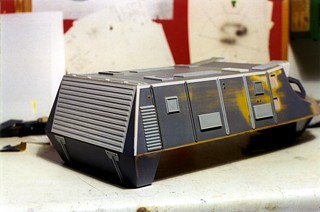
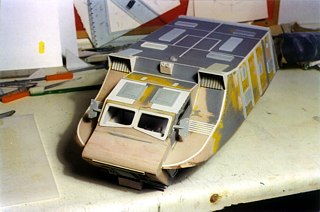 |
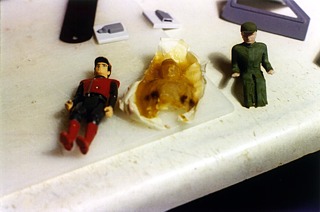 |
I didn’t want a little Joe figure in the cabin so I hunted around
for an adult figure I could use. A cheap Captain Scarlet figure I picked
up from a toy fair was about right, and even had the correct hat, so
I covered the head and torso in about ten layers of quick drying latex
and took a partial cast from which I could create my driver. He didn’t
have to be complete because you can only see the top part of him through
the windows. Then I decided to degrade the inside of the windows to
stop the model looking like a toy, so now you can barely see him at
all.
|
|
In order to make the wheels I had to scratch build one complete wheel
in two separate halves and then mould them.
Construction of each half started with a plastic disc that represented
the middle of the wheel and a section of plastic tube to represent the
hub. The shape of the tyre was then sculpted onto this using car filler.
The hub was then removed and a layer of plastic was vac-formed around
the tyre creating an outer skin onto which the thirty tread patterns
could be drawn and then cut out.
A new piece of plastic tube was glued into the centre and the hub
detail was now scratch built out of plasticard, modified kit parts and
more filler.
|
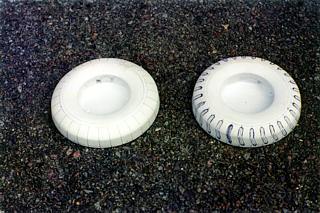 |
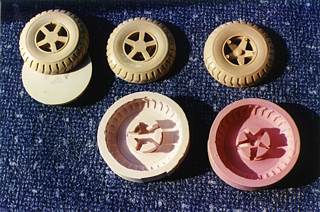 |
I bought a small can of silicon rubber from a local hobby shop, made
moulds of the two wheel halves and then cast up the twenty four halves
I required. This was a very smelly and messy job and it was at this
stage that any thought of making all three trucks went out of the window.
|
|
Each half casting had to be sanded flat and then paired off to create
a whole wheel, a process complicated by the fact that the thickness
of each piece was slightly uneven. These small differences wouldn’t
normally be noticeable but with the wheels being so big in relation
to the rest of the model and also being fixed together in pairs it could
have created a problem. So I had to gauge the thickness of each half
and find the fattest and thinnest parts, and then glue the pieces together
so that the variations would counteract each other and create a balanced
wheel. Then there was also the problem that the casting process generated
some heat, causing the rubber moulds to warm up and expand, which resulted
in creating slightly bigger wheels. Luckily I had made more castings
than I required so the spares came in handy. The wheels were glued together
and fixed onto brass tube axles that ride on supports in the chassis,
cushioned by pieces of foam to create a soft adjustable suspension.
|
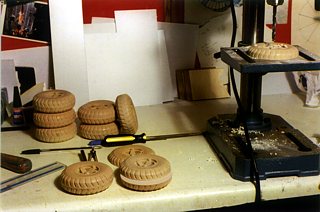 |
 |
The finished model was painted with acrylic
motorcar spray paints and detailed with coloured Letraset flex tapes.
Panel lines were drawn in with a biro and the weathering was added using
black graphite pencil and various enamel paints, which was all sealed
on with clear acrylic lacquer. |
| The white lettering was a bit of a pain as I
didn’t have the correct Letraset for the large numbers and the words
on the rear panel, so these had to be carefully done using masking tapes
during the initial painting stage. The model was painted with white
undercoat, then the letters (photocopied onto adhesive paper) were stuck
in position while the model was sprayed green, and then removed. Any
green paint that had managed to get under the edges of the paper was
either removed or over painted later. |
 |
 |
Finally the rolls of green canvas on the roof
were made from bits of fabric (cut from an old pair of jeans) with Letraset
tape representing the straps. |
| When I started this project I thought it was
going to be a fairly simple and easy model to construct, but it took
a lot more effort than expected. It amazes me even more that the model
makers at the studio managed to produce four models in such a short
space of time for the episode — and they didn’t even have superglue. |
 |
*Webmaster's note: thanks to the internet, we
now know that the elusive wheels originally came from one of the mid-60s 'Johnny
Express' line of commercial truck toys made by US company Topper Toys. However
as David suggests, it seems the wheels used on the models in the episode were
cast from an original and then modified to make them narrower.
(Text and photographs © 2005 David Sisson)























